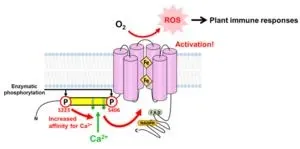Reactive oxygen species (ROS) are highly reactive molecules containing oxygen. These compounds, which are normal byproducts of biological processes in all living organisms such as aerobic respiration as well as photosynthesis, are highly toxic. In most cases, ROS damage cellular machinery and can trigger a harmful stress response if their levels are not kept in tight check; this is why antioxidants are an important part of our diet.
However, over the past few decades, scientists have discovered that ROS are often intentionally generated in cells for various purposes. Professor Kazuyuki Kuchitsu from Tokyo University of Science (TUS) has long been an advocate of the theory that ROS function as a double-edged sword. Through the course of several studies, Prof. Kuchitsu and his colleagues have demonstrated that plants have many types of enzymes that produce ROS in a variety of situations, such as when fighting off a fungal or bacterial infection, during growth, development, and reproduction such as fertilization, and when adjusting to internal or external stress.
In some of these studies, the researchers investigated the mechanisms by which plants regulate the activation of ROS-generating enzymes called NADPH oxidases (also known as RBOHs). They play crucial roles not only in plants but also in animals, including humans, and fungi. However, many aspects of the biological significance of this process still need to be explored. Additionally, it is essential to tightly regulate the activity of these enzymes in all organisms. Studying the evolution of regulatory mechanisms and the function of RBOHs is a significant topic across various research fields, including medical and pharmaceutical sciences and microbiology.
So far, two activation mechanisms have been identified for RBOHs. One involves the binding of calcium ions (Ca2+) at two small structures called EF-hands. The other requires a chemical modification called phosphorylation at specific amino acids; this modification is carried out by protein kinases. However, the precise relationship between these two mechanisms and how they regulate the generation of ROS remains unclear.
Against this backdrop, a research team led by Prof. Kuchitsu and including Mr. Takafumi Hashimoto, a Ph.D. student, Assistant Professor Kenji Hashimoto, Dr. Shoko Tsuboyama, and Mr. Hiroki Shindo, all from TUS, set out to tackle this knowledge gap in collaboration with Dr. Takuya Miyakawa and Prof. Masaru Tanokura. They previously published a study elucidating the function and regulatory mechanisms of plant RBOHs. Now, in their latest article, which was published in the journal Physiologia Plantarum on 12 December 2023, the team revealed the basic mechanisms via which MpRBOHB, an ROS-generating RBOH, is activated. Interestingly, these mechanisms seem to be conserved in RBOHs across all land plants.
The researchers first showed, through experiments with the liverwort model Marchantia polymorpha and genetically modified cell lines, that the activation of MpRBOHB requires not only an increase in intracellular Ca2+ concentration but also binding with Ca2+ ions at two regions in EF-hands spanning about 200 amino acids. In these tests, they used chitin fragments to trigger an immune response in the cells as chitin is an essential component of the cell walls of microorganisms such as molds and fungi.
Next, through a detailed examination of the special regions around the EF-hands highly conserved in all land plants, the researchers identified two serine amino acid residues that, when phosphorylated, increase the Ca2+ binding affinity of MpRBOHB. “Our results reveal that the binding of calcium ions acts as a molecular switch that activates MpRBOHB, and that the phosphorylation of two specific serine residues plays a role in facilitating this binding,” explains Prof. Kuchitsu. “We believe that these mechanisms, orchestrated by a conserved regulatory domain, constitute fundamental regulatory processes governing all land plant RBOHs.”
Understanding how plants regulate ROS-producing enzymes could have tremendous implications for humanity. The insights obtained could lead to tools for manipulating ROS production artificially in plants. In turn, this ability could be used to increase crop yields, make plants more resilient to pollutants or invasive microorganisms, and even leverage plants to clean environmental pollutants.
“The production of ROS plays an extremely wide range of important functions in plants, including growth, reproduction, immunity, and stress response. Appropriate control of this production could therefore help us improve agriculture and food quality, as well as help with environmental remediation,” highlights Prof. Kuchitsu. “This work will hopefully contribute to solving a wide range of social problems related to plants by serving as an extremely important basis for future research.”
With any luck, further unraveling the mysteries of plant biochemistry will open the doors to a safer and more sustainable future!
**
Reference
Title of original paper: Enhanced Ca2+ binding to EF-hands through phosphorylation of conserved Serine residues activates MpRBOHB and chitin-triggered ROS production
Journal: Physiologia Plantarum
DOI: https://doi.org/10.1111/ppl.14101
About The Tokyo University of Science
Tokyo University of Science (TUS) is a well-known and respected university, and the largest science-specialized private research university in Japan, with four campuses in central Tokyo and its suburbs and in Hokkaido. Established in 1881, the university has continually contributed to Japan's development in science through inculcating the love for science in researchers, technicians, and educators.
With a mission of “Creating science and technology for the harmonious development of nature, human beings, and society," TUS has undertaken a wide range of research from basic to applied science. TUS has embraced a multidisciplinary approach to research and undertaken intensive study in some of today's most vital fields. TUS is a meritocracy where the best in science is recognized and nurtured. It is the only private university in Japan that has produced a Nobel Prize winner and the only private university in Asia to produce Nobel Prize winners within the natural sciences field.
Website: https://www.tus.ac.jp/en/mediarelations/
About Professor Kazuyuki Kuchitsu from Tokyo University of Science
Kazuyuki Kuchitsu is a Professor in the Department of Applied Biological Science at the Tokyo University of Science, Japan. He obtained a PhD from the University of Tokyo Graduate School in 1990. His research areas include plant cell and molecular biology, signal transduction, stress responses, and reactive oxygen species. He has published over 130 papers on these topics. Prof. Kazuyuki has also won many awards, including multiple Best Imaging Awards and an Editor's Choice Award in 2022.
Funding information
This study was supported in part by JSPS KAKENHI Grant Numbers JP26111008, JP20H02990, and JP22H04734.
END







